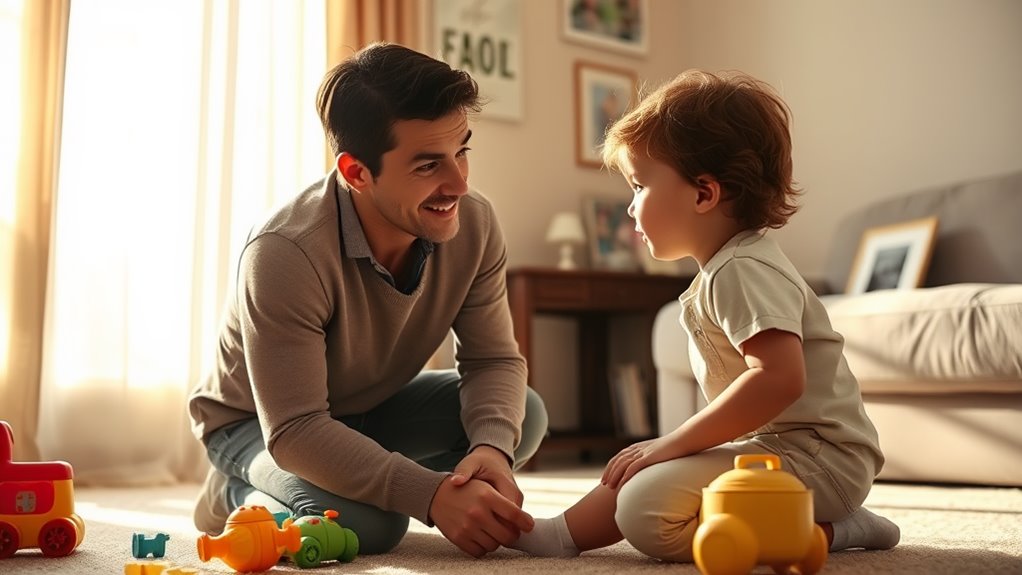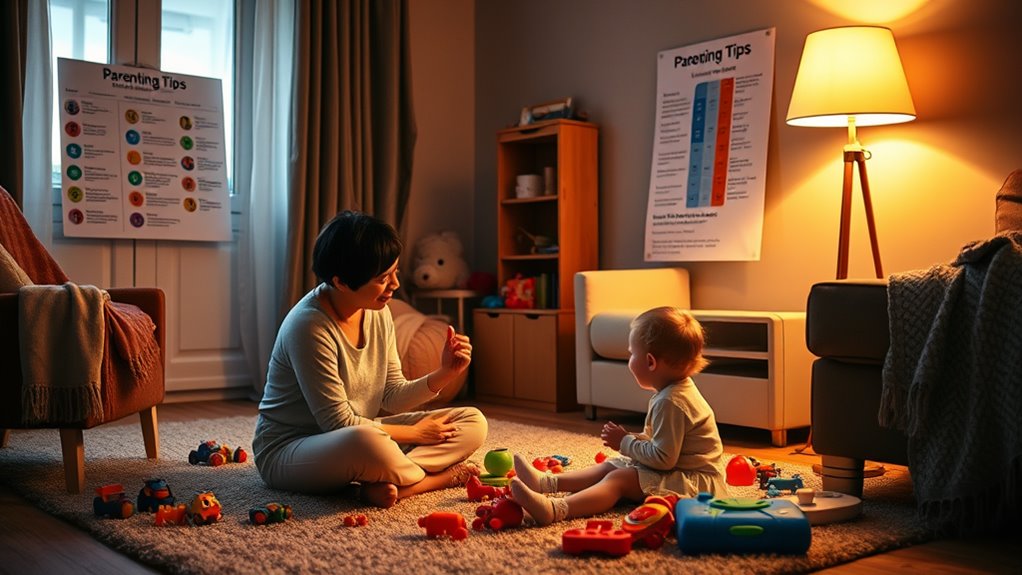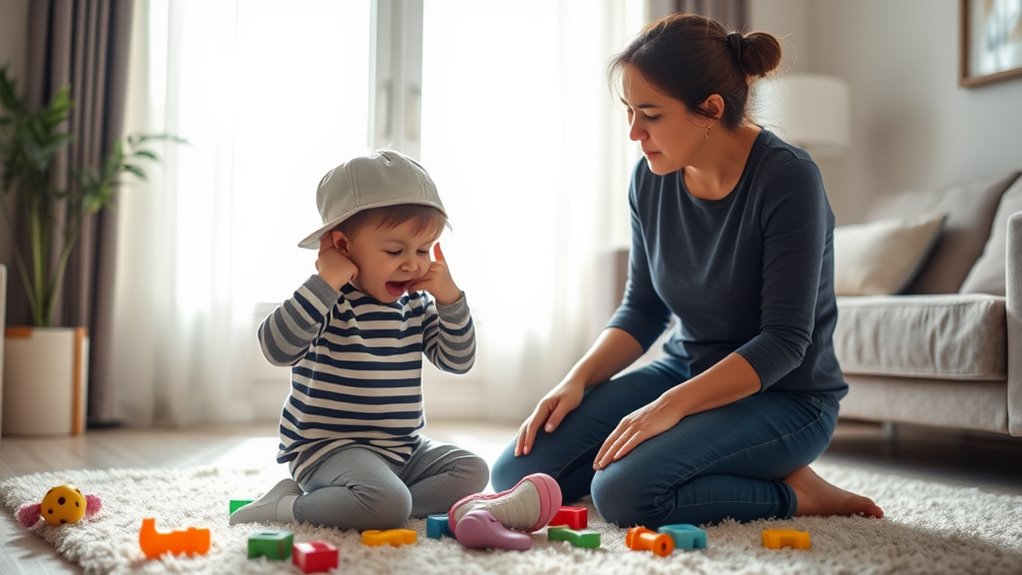How to Get Your Kids to Listen Without Yelling
To get your kids to listen without yelling, start by understanding their perspective; this builds empathy. Set clear expectations and discuss rules openly, so they know what’s important. Use positive reinforcement to motivate them, celebrating their efforts and good behavior. Model active listening by giving them your full attention—make eye contact and show interest in their words. Lastly, create a calm environment with consistent routines and limited distractions. This approach encourages your kids to respond positively and engage more effectively. Keep following these tips to discover even more strategies that can transform your communication.
Key Takeaways
- Engage in active listening to show your child their thoughts and feelings are valued, fostering better communication.
- Set clear and consistent expectations to help your child understand acceptable behaviors and reduce confusion.
- Use positive reinforcement to highlight good behavior and encourage your child to comply without the need for yelling.
- Create a calm environment with routines that provide security, making it easier for children to listen and respond.
- Utilize open-ended questions to encourage dialogue, allowing your child to express themselves and feel heard.
Understand Your Child’s Perspective
To effectively connect with your child, it’s crucial to understand their perspective. Kids often see the world differently than adults do, and by practicing perspective taking, you can bridge that gap.
Start by engaging in empathy exercises that encourage you to step into their shoes. Ask open-ended questions about their feelings and thoughts, and really listen to what they say. This not only validates their emotions but also helps you grasp their viewpoint.
Consider role-playing scenarios where you and your child can switch roles. This fun activity allows both of you to express your feelings and understand each other’s experiences better. When you acknowledge what they’re going through, you create a safe space for your child to share more openly.
Also, pay attention to non-verbal cues like body language and facial expressions. These can give you insights into how your child is feeling.
Set Clear Expectations
Setting clear expectations is essential for effective communication with your kids. When you establish consistent rules, you create a framework that helps them understand what’s expected of them. It’s important to sit down with your children and discuss these rules openly. Make sure they know why these expectations matter and how they affect the family dynamic.
Using clear communication is key. Avoid vague phrases like “be good” or “behave.” Instead, specify what you want them to do, such as “Please put your toys away after playing” or “Finish your homework before dinner.” This clarity reduces confusion and gives them a better understanding of their responsibilities.
Also, be sure to review these expectations regularly. Kids grow and change, and so should the rules. When you keep the lines of communication open, it encourages them to ask questions and express any feelings about the rules.
This ongoing dialogue fosters a sense of trust and respect, making it easier for them to adhere to the established expectations. By setting clear boundaries, you’re not just making demands; you’re empowering your kids to succeed in meeting them.
Use Positive Reinforcement
Positive reinforcement is a powerful tool that can transform how your kids respond to expectations. Instead of focusing on what they do wrong, highlight their positive behaviors.
You can create simple reward systems that encourage them to follow directions and complete tasks. For instance, consider implementing a sticker chart where they earn a sticker for each successful task completed. After reaching a certain number, they could receive a small reward, such as an extra story at bedtime or a fun outing.
Don’t underestimate the impact of praise. When your kids make an effort, whether big or small, acknowledge it. Saying things like, “I really appreciate how you helped clean up,” reinforces their positive behavior and motivates them to keep it up.
The key is consistency; the more you reward and praise their efforts, the more they’ll associate good behavior with positive outcomes.
Model Active Listening
While it’s easy to get caught up in the hustle of daily life, modeling active listening is crucial for teaching your kids the importance of communication. When you actively listen, you show your children that their thoughts and feelings matter. This not only fosters a deeper connection but also encourages them to practice the same skills.
Here are three ways to model active listening for your kids:
-
Use Attentive Body Language*: Show that you’re engaged by maintaining eye contact, nodding, and leaning slightly towards them. This non-verbal communication signals that you’re *genuinely interested in what they’re saying.
-
Practice Reflective Responses*: Repeat back what they’ve said to confirm your understanding. For example, you might say, “So, you’re feeling upset because you lost your toy?” This helps them *feel heard and encourages them to express themselves more openly.
-
Limit Distractions: When your child is speaking, put aside your phone or turn off the TV. This shows them that their words deserve your full attention, reinforcing the importance of focused communication.
Create a Calm Environment
Creating a calm environment can significantly enhance your child’s ability to listen and engage in meaningful conversations. When you establish peaceful routines, your child knows what to expect, which reduces anxiety and creates a sense of security. Consistency is key; try to maintain regular mealtimes, homework sessions, and bedtime rituals. This predictability helps them feel grounded and more open to communication.
Additionally, consider incorporating sensory spaces in your home. Designate a quiet area filled with soothing elements like soft pillows, calming colors, and gentle lighting. This space can serve as a retreat for your child when they feel overwhelmed. Encourage them to use it when they need a moment to collect their thoughts or just unwind.
When you create an atmosphere of tranquility, your child is more likely to respond positively to your requests and engage in discussions. Be mindful of noise levels and distractions, too; limit screen time and background noise during important conversations.
Frequently Asked Questions
What Age Is Best to Start Teaching Listening Skills?
It’s best to start teaching listening skills around age two, when kids hit key listening milestones. You can use age-appropriate strategies like interactive games and storytelling to help them develop these essential skills effectively.
How Can I Handle Defiance in Children Effectively?
Dealing with defiance can feel overwhelming, but it doesn’t have to. Try using defiance strategies focused on respectful communication. Encourage open dialogue, listen actively, and set clear expectations to foster cooperation in your child.
What Are Some Effective Listening Games for Kids?
For effective listening activities, try fun exercises like “Simon Says” or “Mystery Sounds.” These games not only engage your kids but also help them develop essential listening skills in an enjoyable way that keeps them interested.
How Do I Stay Calm During Stressful Parenting Moments?
In those hectic moments, it’s essential to find your center. Try mindful breathing to regain composure, and remember, positive reinforcement can transform challenges into opportunities, helping you navigate parenting’s stormy seas with grace and patience.
Can Technology Help Improve My Child’s Listening Skills?
Absolutely, technology can enhance your child’s listening skills. Consider using listening apps that make learning fun. Just balance screen time to ensure it complements their development, rather than replacing important interactions and activities.





